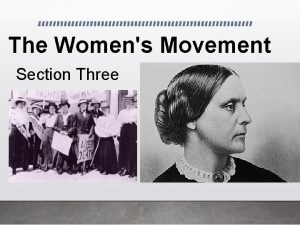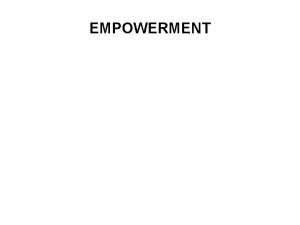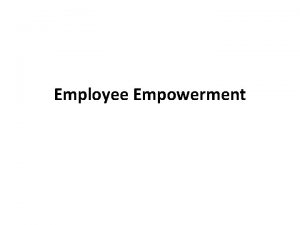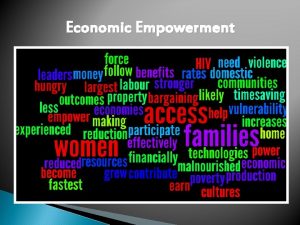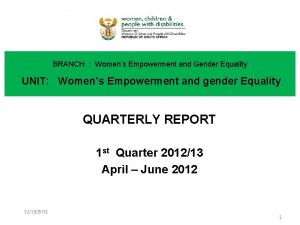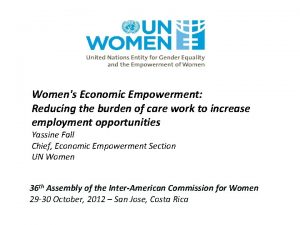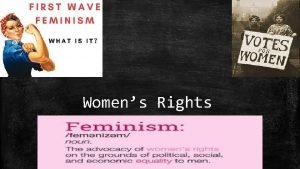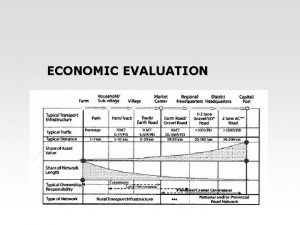Womens Economic Empowerment and Care An evaluation of













- Slides: 13

Women’s Economic Empowerment and Care An evaluation of the consideration of care in conceptualizations of women’s economic empowerment Deepta Chopra, Zahrah Nesbitt-Ahmed and Priya Raghavan

A Review of the Literature: Composite Definition ¡Improving women’s access to economic resources and income through enhancement of economic opportunities and participation in the labour market, and increasing women’s agency and control over household resources and decision making

A Review of the Literature: Key Debates ¡process vs goal approach ¡aims and targets vs institutions and structures ¡creation of opportunities vs removal of constraints ¡ instrumental vs substantive ¡ individualized vs collective

Resultant strategies and programmes Logic of WEE: access to financial resources -> higher decisionmaking/ social household standing -> empowerment through economic participation ¡Provision of paid work: public works, job creation, labour force expansion. Eg: MGNREGA India ¡Facilitation of paid work: education, training, savings. Eg: SEWA, India ¡Enabling environment: structural provisions such as legislation, frameworks and collective action. Eg: Employment and Labour Relations Act, Tanzania

What is Care ¡Meeting the material and/or developmental, emotional and spiritual needs of other people through direct personal relationships ¡Care has a widespread, long-term, positive impact on wellbeing and development, it underpins all development policy & is critical to ensuring sustainable economic empowerment of women and girls & addressing inequality and vulnerability.

Why Care in WEE ¡WEE is not simply about labour force participation, but also about the choice to work, the choice of sector, location and working hours ¡Care obligations impacts the type, location and nature of paid work that women and girls can undertake ¡ Women forced to assume informal, insecure poorly paid roles ¡ Correlation between women’s stages of life and entry into the labour force

Locating Care in WEE Literature ¡Care considerations entirely invisible in a majority of WEE conceptualizations (exceptions being secondary consideration in OECD, 2011 and Tornqvist and Schmitz, 2009) ¡Most conceptualizations oriented towards an ideal/ imagined ideal of economic participation without grounding themselves sufficiently in the development reality of women, resulting in the creation of a double burden

Implications of Ignoring Care in WEE ¡Failure to consider care translates to un-situated policies and programmes with outcomes that are ¡ limited ¡ individualised ¡ unsustainable

Potential Entry Points for Care ¡WEE literature contains remote allusions to care that provide potential entry points ¡ Removal of barriers to entry ¡ Enhancing access ¡ Recognizing the value of unpaid contributions ¡ Improving labour market conditions

Integrating Care with WEE Bringing choice to the center of WEE through a consideration of care: Expanding women’s choices of where to work, sector, location and type of work while creating a double boon: paid work that empowers women at the same time through strategies that ¡ Recognize care and care work ¡ Reduce difficult, inefficient tasks ¡ Redistribute responsibilities ¡ Represent women in planning

How will this translate to better policies/ outcomes? Support for unpaid care work will: ¡Optimise women’s economic participation, by enabling them to work without deepening their time poverty ¡Share the gains of women’s economic empowerment across all females in the family ¡Sustain the gains of women’s economic empowerment across generations

Potential Policy Prescriptions https: //www. youtube. com/watch? v=VVW 858 g. QHo. E

Thank You!
 Transgender economic empowerment project
Transgender economic empowerment project Differences between men's and women's soccer
Differences between men's and women's soccer Primary secondary tertiary care nursing
Primary secondary tertiary care nursing Womens ministry activities
Womens ministry activities Womens rights
Womens rights Late night womens hour
Late night womens hour Aylesbury womens aid
Aylesbury womens aid Womens right
Womens right Womens college kumbakonam
Womens college kumbakonam Womens college kumbakonam
Womens college kumbakonam Womens right
Womens right Womens shelter edmonton
Womens shelter edmonton Women's rights
Women's rights Functions of the uterus
Functions of the uterus




